some pink and some socks of the color of the soles (or wool for felting, if you decide to roll piles);
I draw your attention that the wire must be sufficiently rigid. It should not be very tight around the delays of the trunk. I stuffed only the upper part of the trunk, the bottom did not stuff.
fill, insert the wire (I wrapped it with a plaster) and then fill as knitting around the wire (not tight).
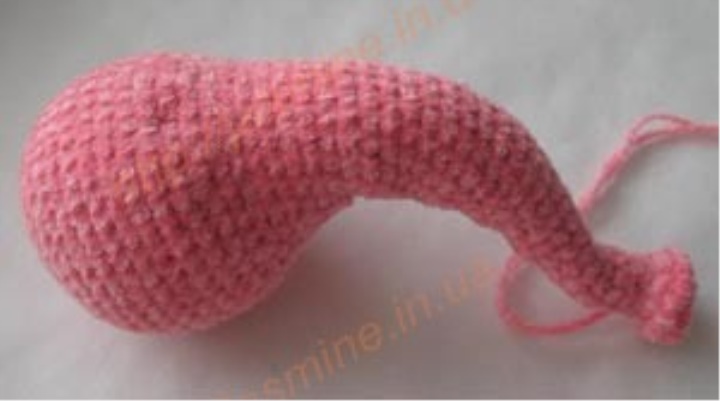
To form the tip of the trunk, focusing on the photo
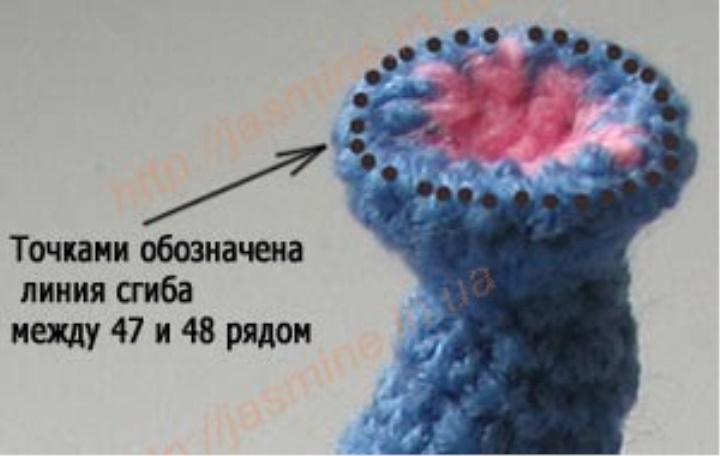
Can be a little flatten proboscis at the edges.
Ears
We will have a left and a right ear, they are knitted in different ways (in a mirror image). The inside is the inside of the ear (if you knit inside out, then vice versa).
The left ear (as viewed on a muzzle elephant)
2 ch
1 r 6 PTBs second loop from the hook
2 r 6 of increases (12)
3 p: (2 PTBs, 2V) x 3 (18)
4 p (4 PTBs, 2V ) x3 (24)
5 p: (6 stbn, 2V) x3 (30)
6 p: (8 stbn, 2V) x3 (36)
7 p: (10 stbn, 2V) x3 (42)
8 p: (12 stbn , 2V) x3 (48) To
fasten a thread, you can leave a long end for sewing the eyelet to the head.
Right ear
2 ip
1 p: 6 stbn in the second loop from the hook
2 p: 6 increments (12)
3 p: (2V, 2 stbn) x3 (18)
4 p: (2V, 4 stbn) x3 (24)
5 p: (2V, 6 stbn) x3 (30)
6 p: (2V, 8 stbn) x3 (36)
7 p: (2V, 10 stbn) x3 (42)
8 p: (2V, 12 stbn) x3 (48) The
thread can be fastened ;
These are the ears we get:

Taurus
2 B1
1 p: 6 stbn to the second from the hook
2 p: 6 increases (12)
3 p: (1 stbn, V) x6 (18)
4 p: (2 stbn, V) x6 (24)
5 p: ( 3 stbn, V) x6 (30)
6 p: (4 stbn, V) x6 (36)
7 p: (5 stbn, V) x6 (42)
8 - 13 p: 42 stbn
14 p: 3 stbn, A, (1 stbn, 2A) x2, 1 stbn, A, 24 stbn (36) - forming the ass with an elephant slice
15 p: 36 stbn
16 p: 18 stbn, (A, 1 stbn) x6 (30) - forming an splash with the slon
17 in downpainting - 19 pp: 30 stbn
20 p: (3 stbn, A) x6 (24)
21 p: 24 stbn
Begin to fill
22 p: (2 stbn, A) x6 (18)
23 p: (1 stbn, A) x6 ( 12)
24 r: decreasing before closing
Fasten the thread and hide inside the parts.
Here is the little body we get:
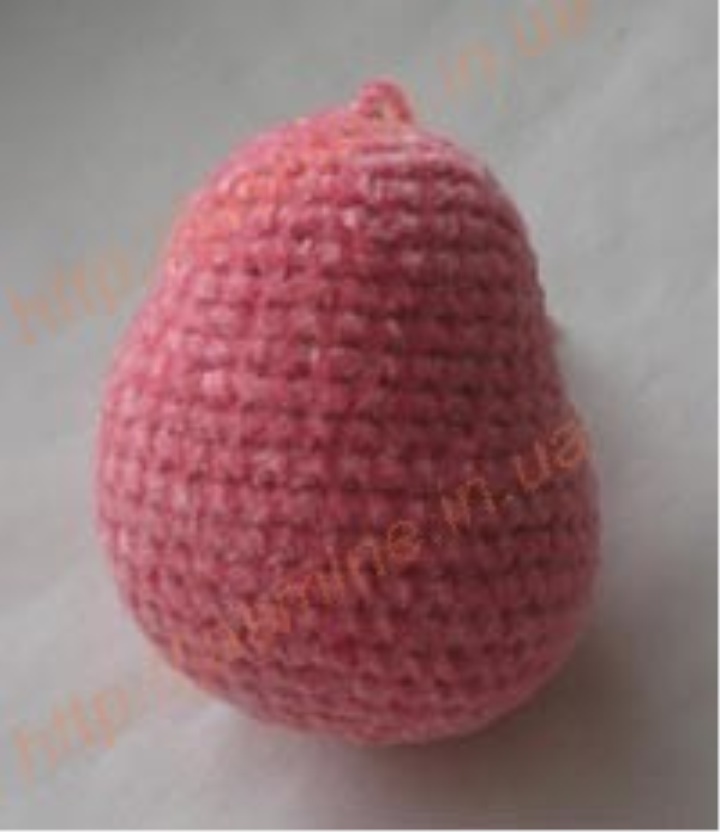
Pens (2 parts)
(Probably the elephants in real life do not have pens, but ours are fabulous!)
We start to knit with
2
pill staples in 1 p: 6 stbn second from the hook
2 p: 6 gains (12)
3 p: (2 stb , V) x4 (16)
Change the thread color to the primary
4 p: 16 stbn behind the back wall of the loops
5 - 7 pp: 16 stbn
8 p: 3A, 10 stbn (13)
9 - 17 pp: 13 stbn
18 p: (1 stbn, A) x4, 1 stbn (9)
19 p: decrease to close Secure
and hide the thread inside the parts.
These are the pens we get:
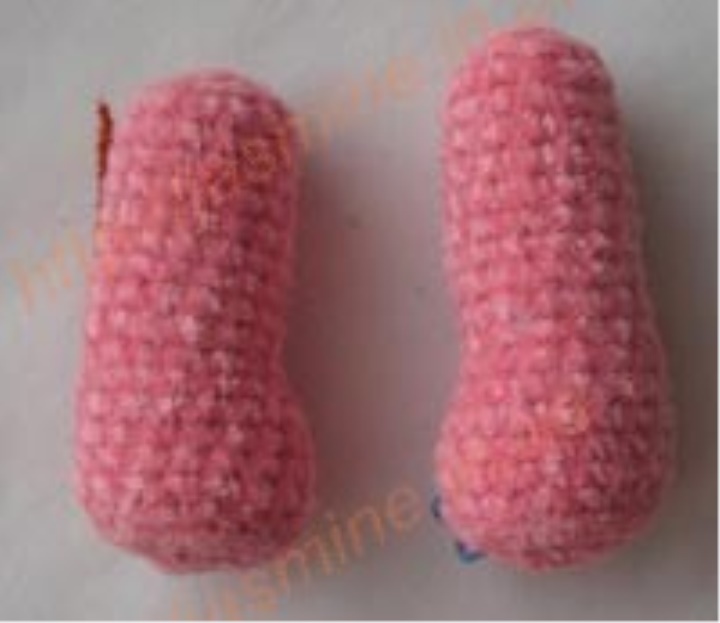
Legs (2 parts)
We start to knit with the color of pins
2 Bp
1 p: 6 stbn to the second from the hook
2 p: 6 gains (12)
3 p: (1 stbn, V) x6 (18)
Change the color of the thread to the main
4 p: 18 stbn for the back wall of the hinges
5 - 7 pp: 18 stbn
8 p: 3A, 12 stbn (15)
9 - 15 pp: 15 stbn
16 p: (1 stbn, A) x5 (10)
17 p: decrease to close
Thread to fix and hide inside the parts.
These are the legs we get:

Tail and assembly The
tails of the elephants are small.
At the level of 8 rows of the calf, in the middle of the butt, attach the thread of the main color and tie a chain of 5-6 air loops. Fasten the thread well and cut.
Getting to make a face Slonyashe
I did utyazhechki for the eyes. Pins marked out places for the eyes, a needle with a strong thread introduced in the place where our little head (more precisely, Slonyashin) would be attached to the calf, brought out in the place where the left eye of the Elephant was supposed to be, retreated to a row or two and removed the needle with the thread in the same place where it was originally introduced. Do the same for the right eye.

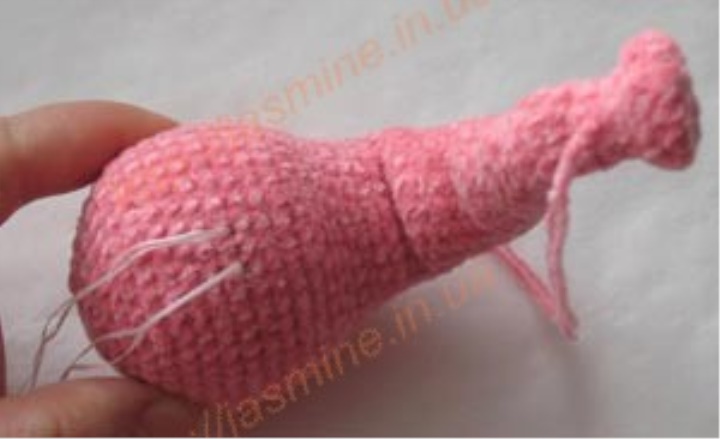
Here you need to decide which eyes your Elephant has. I used a piece of felt as a white eye and half bead. Attach your eyes to the places utyazhek and see if you like. You can make an additional utyazhchku between the eyes. Eye attachment can be slightly ottonirovat. I tinted the usual blush.
Sew the ears. Embroider the edge of the Elephant. If desired, you can glue the cilia (preferably at the very end of the assembly).
Sew the head to the calf. Pin pins pens (I draw your attention to the fact that the places of the delays on the handles should be turned to the calf when sewing) and the legs. If you like the location, make a thread mount.
Your Elephant is ready! :)
Both these elephant sticks are related by the same description:
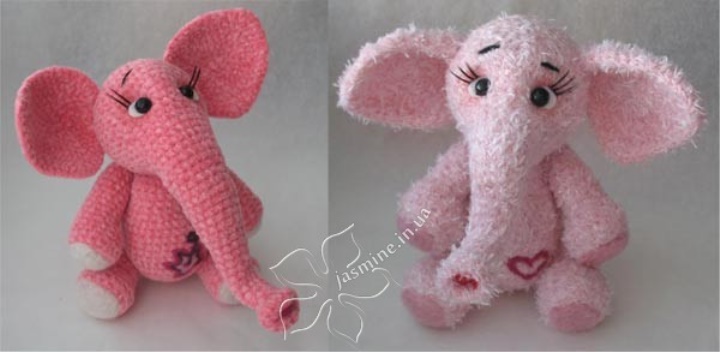
Source : http://jasmine.in.ua